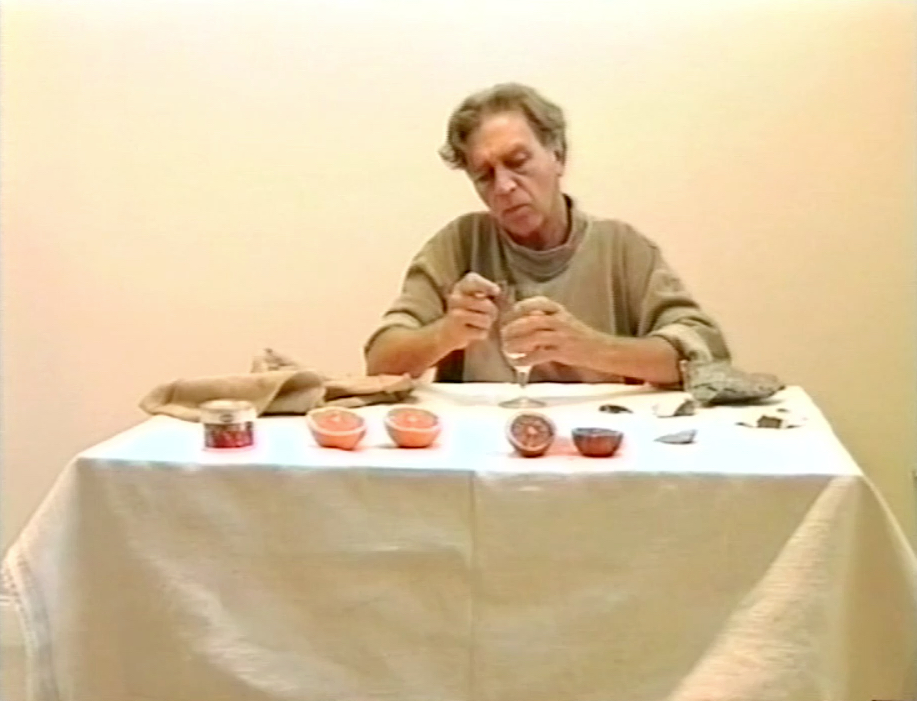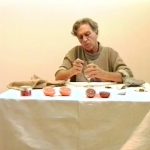Collected Stones
TITLE
Collected Stones
DIRECTOR
Jimmie Durham & Maria Thereza Alves
COUNTRY
USA, Germany, Brazil
YEAR
2002
DURATION
22′
GENRE
Video Art
Overview

Collected Stones
Jimmie Durham was an artist, poet, writer, and activist whose work deconstructs the stereotypes and prejudices that underlie Western culture. Expanding on this theme, the film works—created in collaboration with his life partner, Maria Thereza Alves— Collected Stones (Incident at Middelberg, A Sone from Metternich's House in Bohemia, 13 Rue Fenelon, Enough!, A Heavy Stone, HTV, Pink Granite at Work, Un Projet a Lille, Nature Morte, Towards Light, A Stone at Home in Bed Asleep, Stoning the Refrigerator, Brazilian Bloodstone)— carry strong critical resonance. Each film examines the relationship between history and environment, architecture and monumentality, and challenges political power structures and national identity narratives. Within these works, Durham depicts behaviors and norms of coexistence across diverse social and cultural formations. As extensions of his sculpture, drawings, and poetry, Durham’s films investigate how people engage with both physical and societal architectures. Their titles reflect wordplay, dry and incisive humor, and, above all, irony. He consistently critiques the political and cultural forces that shape contemporary discourse, histories of oppression, the futility of violence, and the marginalization of minority groups. Using both natural and artificial materials, Durham favors those historically employed as tools. He explores the intrinsic properties of bones, wood, feathers, and stones—materials he gathers on walks. This approach is evident in the films from the Collected Stones. For Durham, stone is neither material nor metaphor; it is a generative force that resists institutionalization, representation, and monumentality.
DIRECTOR BIOGRAPHY - Jimmie Durham & Maria Thereza Alves
Jimmie Durham 1940, United States – 2021 Berlin. In his artistic research, Jimmie Durham was interested in what happens “away from language,” in the relationship between forms and concepts. Working against Western Rationalism, his practice was rooted in uncertainty and paradox. Durham created in an array of mediums: drawings, installations, video (which he used to document his performances), and sculptural constructions often combined with written messages, photographs and objects. Covering a broad range of subject matter in artworks—as well as in essays and poetry—his production was often laced with the agility of wordplay, a dry, highly critical humor and, above all, insight. He consistently addressed the political and cultural forces that construct our contemporary discourses, the history of oppression, the futility of violence and the powerlessness of the minorities in the world. Durham worked with both natural and artificial materials, and was particularly drawn to the intrinsic qualities of those that have been used throughout history as tools: stone, wood, bone, iron and glass. Stone was a primary material for Durham due to its role in defining power dynamics of culture and society through architecture and ideas of monumentality; he used it to underscore the polemics of nature vs. culture, religion, architecture, and Eurocentric ideas of history.
Credits
- DirectorJimmie Durham & Maria Thereza Alves
- Screenplay
- Cinematography
- Cast
- Editing
- Producer/s
- Production Company
- Distributor/s
- Project TitleCollected Stones
- Project TypeVideo Art
- Completion Date2002
- Country of originUSA, Germany, Brazil
- Country of filmingUSA, Germany, Brazil
- Language
- First-time Filmmaker No
- Student ProjectNo
Jimmie Durham & Maria Thereza Alves
Jimmie Durham 1940, United States – 2021 Berlin. In his artistic research, Jimmie Durham was interested in what happens “away from language,” in the relationship between forms and concepts. Working against Western Rationalism, his practice was rooted in uncertainty and paradox. Durham created in an array of mediums: drawings, installations, video (which he used to document his performances), and sculptural constructions often combined with written messages, photographs and objects. Covering a broad range of subject matter in artworks—as well as in essays and poetry—his production was often laced with the agility of wordplay, a dry, highly critical humor and, above all, insight. He consistently addressed the political and cultural forces that construct our contemporary discourses, the history of oppression, the futility of violence and the powerlessness of the minorities in the world. Durham worked with both natural and artificial materials, and was particularly drawn to the intrinsic qualities of those that have been used throughout history as tools: stone, wood, bone, iron and glass. Stone was a primary material for Durham due to its role in defining power dynamics of culture and society through architecture and ideas of monumentality; he used it to underscore the polemics of nature vs. culture, religion, architecture, and Eurocentric ideas of history.




